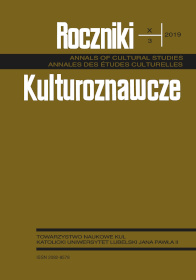The Machine in the Body—the Body in the Machine: Perception of the Human Body in a Post-Biological Society
Abstract
The aim of the article is to provide a critical analysis of the body-machine relationship in the context of post-biological society (as viewed by Roy Ascott) from two perspectives (David Tomas): on the one hand the functioning of the machine in the body as a manifestation of transgression and on the other one—the functioning of the body in the machine as a challenge and assumption of transhumanism. The term ‘machine’ in this article is limited to the cybernetic machine. This article is limited to a critical analysis of a new type of person: a cyborg—a hybrid of a human being and a machine in a post-biological society.
The following research question has been formulated: what image of the body is suggested, imposed, or maybe enforced by a post-biological society? How does the body function and influences the machine (the body inside the machine), how does the machine influence the body (the machine inside the body) and finally—how do these relationships relate to the broader social context? Are the attempts within hybridization and transhumanism not leading to the internet of bodies? Can an internet of bodies be developed just like the internet of things? The article accepts the hypothesis that crossing subsequent boundaries of the human body in a post-biological society changes the body-machine relationship. The nature of the article is analytical-descriptive and conceptual. The thesis has been confirmed.
References
Ascott, Roy. “Behaviourables and Futuribles.” In Theories and Documents of Contemporary Art: A Sourcebook of Artists’ Writings, edited by Kristine Stiles, Peter Howard Selz, 489–491. Berkely & Los Angeles: University of California Press, 1996.
Ascott, Roy. “Consciousness reframed: Art and consciousness in the post‐biological era.” Digital Creativity 9, no. 1(1998): Computers & Post-Biological Art: 5–6.
Ascott, Roy. The architecture of cyberception. Stambuł: Leonardo Electronic Almanac, 1994.
Bakke, Monika. Ciało otwarte: filozoficzne reinterpretacje kulturowych wizji cielesności. Poznań: Wydawnictwo Naukowe UAM, 2000.
Bostrom, Nick et al. Transhumanistyczne FAQ (czyli transhumanistyczne pytania i odpowiedzi), http://www.transhumanism.org/index.php/WTA/more/659/ (accessed: 3.10.2019).
Bostrom, Nick. “In Defense of Posthuman Dignity.” Bioethics 19, no. 3(2005): 202–214.
Braidotti, Rosi. The Posthuman. Oxford: Polity Press, 2013.
Clynes, Manfred E. & Nathan Kline. “Cyborgs and Space.” Astronautics no. 8(1960): 29–33. https://pl. scribd.com/doc/2962194/Cyborgs-and-Space-Clynes-Kline?autodown=pdf (accessed: 3.10. 2019).
Derrida, Jacques. “Jednojęzyczność innego, czyli proteza oryginalna.” Translated by Andrzej Siemek. Literatura na Świecie no. 11-12(328-329)(1998): 24–111.
Drenda, Olga. “Maszyna i operator. Transhumanistyczna wizja ciała.” Znak no. 4(2011): 674–675.
Droga do nieśmiertelności po przez [sic!] umaszynowienie ludzi. To się już dzieje. http://globalne archiwum.pl/droga-do-niesmiertelnosci-po-przez-umaszynowienie-ludzi-to-sie-juz-dzieje/ (accessed: 2.11.2019).
Franckiewicz-Olczak, Izabela. “Body art—ciało, sztuka, technologia. Od ciała ułomnego do bezawaryjnego humanoida.” Przegląd Socjologii Jakościowej 8, no. 2(2012): 228–241.
Gruchoła, Małgorzata. “‘Wearable technology’ wyznacznikiem transgresji czy regresu intelektualno--kulturowego? (na przykładzie transhumanizmu).” Społeczeństwo i Rodzina 55, no. 2(2018): 50–65.
Haraway, Donna. “A cyborg manifesto: Science, technology, and socialist-feminism in the late twentieth century.” In Simians, cyborgs and women: The reinvention of nature, 149–181. New York: Routledge, 1991.
Kilian, Edyta. “Roman Bromboszcz jako poeta-cyborg. Narzędzia i techniki współczesnego twórcy.” In Technokultura: transhumanizm i sztuka cyfrowa, edited by Damian Gałuszki, Grzegorz Ptaszek, Dorota Żuchowska-Skiba, 213-235. Kraków: Wydawnictwo Libron, 2016.
Knapczyk, Józef. Zarys robotyki. Nowy Sącz: Wydawnictwo Naukowe Państwowej Wyższej Szkoły Zawodowej w Nowym Sączu, 2015.
Kozielecki, Józef. Społeczeństwo transgresyjne. Szansa i ryzyko. Warszawa: Wydawnictwo Akademickie „Żak”, 2004.
Loretz, Carike. “The World Wide Web—from Web 1.0 to Web 5.0.” https://carikesocial.wordpress. com/2017/03/15/the-world-wide-web-from-web-1-0-to-web-5-0/ (accessed: 2.05.2019).
Moll, John. Naukowcy skopiowali umysł człowieka i umieścili go w maszynie. https://tylkonauka. pl/wiadomosc/naukowcy-skopiowali-umysl-czlowieka-umiescili-go-w-maszynie (accessed: 11.10.2019).
Moravec, Hans. Mind Children: The Future of Robot and Human Intelligence. Cambridge, Mass: Harvard University Press, 1988.
Morbitzer, Janusz. “Człowiek w świecie technologii informacyjnych.” In Edukacja artystyczna a rzeczywistość medialna, edited by Romualda Ławrowska, Bożena Muchacka, 20–34. Kraków: Wydawnictwo Naukowe Uniwersytetu Pedagogicznego, 2009.
Mushiaki, Shigeru. “Neuroscience and nanotechnologies in Japan—beyond the hope and hype of converging technologies.” International Journal of Bioethics 22, no. 1(2011): 91–97.
Musk, Elon. “Elon Musk Biography.” https://www.biography.com/business-figure/elon-musk (accessed: 12.05.2019).
Ogonowska, Agnieszka. “Ubiór jednostki jako przedmiot interpretacji i badań interdyscyplinarnych”. In Komunikacja wizualna, edited by Piotr Francuz, 229–243. Warszawa: Wydawnictwo Naukowe Scholar, 2012.
Orlan. http://www.orlan.eu/ (accessed: 28.12.2019).
Palese, Emma. “Robots and cyborgs: to be or to have a body?” Poiesis & Praxi 8, no. 4(2012): 191–196.
Prof. Roy Ascott (Wielka Brytania). http://www.poznan.pl/mim/main/prof-roy-ascott-wielka-brytania,p,12973,23787,23930.html (accessed: 07.10.2019).
Roco, Mihail C. & William S. Bainbridge. “Overview Converging Technologies for Improving Human Performance.” In Converging Technologies for Improving Human Performance, edited by Mihail C. Roco & William S. Bainbridge, 1–27. Dordrecht: Kluwer Academic Publishers currently Springer, 2004.
Sarowski, Łukasz. “Robot społeczny – wprowadzenie do zagadnienia.” Roczniki Kulturoznawcze 8, no. 1(2017): 75–89.
Šmid, Wacław. Leksykon komunikacji medialnej. Kraków: Dr Lex, 2010.
Springer, Claudia. Electronic Eros. Bodies and Desire in the Postindustrial Age. Texas: University of Texas Press, 1996.
Starkowski, Maciej. “Technicyzacja ciała. Pytanie o człowieka.” In Umysł—Ciało—Sieć, edited by Edyta Stawowczyk-Tsalawoura, Wojciech Chyła, 125–136. Poznań: Wydawnictwo Naukowe UAM, 2005.
Stelarc. http://stelarc.org/projectp.php (accessed: 3.10.2019).
Stelarc. Stomach Sculpture. http://stelarc.org/?catID=20349 (accessed: 28.12.2019).
Szulich-Kałuża, Justyna & Grzegorz Winnicki. “Portretowe odsłony Leszka Mądzika—w poszukiwaniu malarskich inspiracji na fotoportretach artysty.” In Artes Liberales. Teatr—Sztuka—Media, edited by Stanisław Fel, Justyna Szulich-Kałuża, Paweł Nowak, Małgorzata Sławek-Czochra, 305–322. Lublin: Wydawnictwo KUL, 2018.
Vinge, Vernor. The Coming Technological Singularity. https://edorap.sdsu.edu/~vinge/misc/singula rity.html (accessed: 13.10.2019).
Znamię Bestii, prace nad cyborgizacją umaszynowieniem ludzi. http://globalne-archiwum.pl/znamie-bestii-i-prace-nad-cyborgizacja-umaszynowieniem-ludzi/ (accessed: 19.10.2019).





